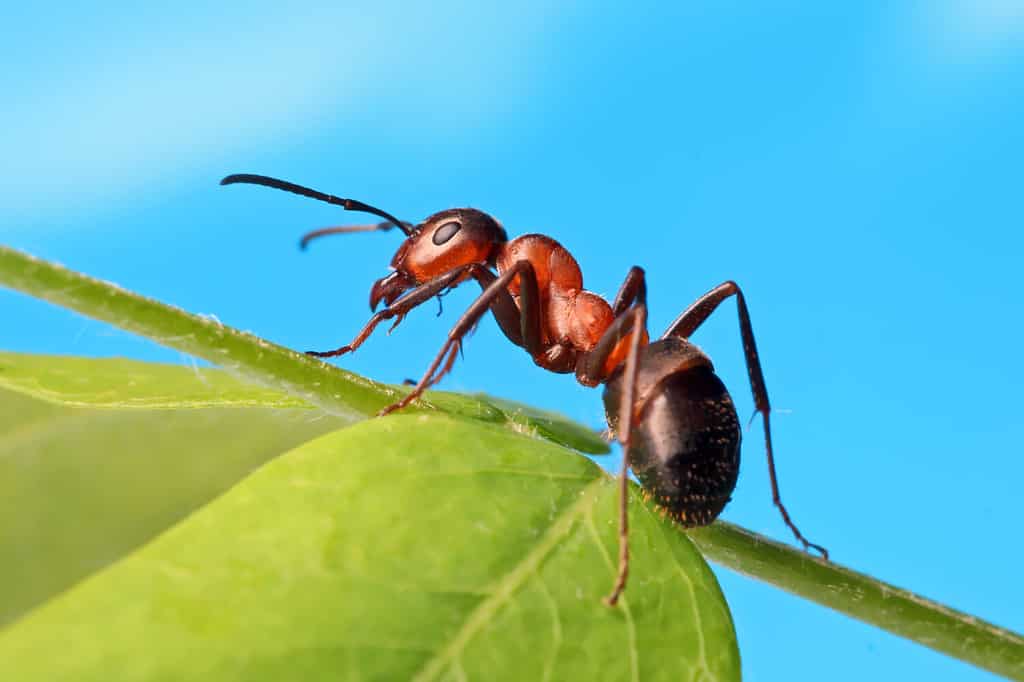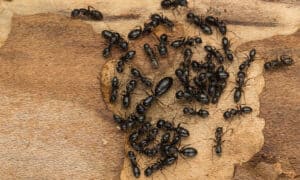Ants are small, six-legged insects that live in colonies of varying sizes. They can be found all around the world and in a variety of climates, from deserts to rainforests. Ants have adapted to survive in almost any environment by forming complex social societies with well-defined roles for each individual ant. They communicate through pheromones and other chemical signals as they search for food, build nests, care for their young, and defend their colony against predators or intruders. On average, an ant is about one-tenth of an inch long, but some species can grow up to two inches!
Do Ants Have Hearts?

Two pavement ants (
Tetramorium immigrans)greet each other on stone.
©Ernie Cooper/Shutterstock.com
Do ants have hearts? The answer is yes, ants have hearts! However, their heart structure and function differ greatly from a human heart. Ants’ hearts are in the form of an elongated tube located near the center of their thorax. This tubular structure pumps hemolymph, which is a type of fluid similar to blood but with fewer cells and less oxygen transport capacity than human blood. It helps provide nutrients to all parts of the ant’s body as well as allowing them to move by contracting muscles along its length.
Additionally, this tubular heart has several holes that allow for waste products such as carbon dioxide to be released into air sacs before exhaling out through spiracles on the sides of the body. In contrast to humans, who have four-chambered hearts that help pump oxygen-rich blood throughout our bodies, ants rely on this single tubular organ for most transportation needs within their anatomy.
Do Ants Have Blood?
Do ants have blood? The answer to this question is yes; ants have a fluid that circulates throughout their bodies. This fluid, known as hemolymph, shares many similarities with human blood. Hemolymph carries nutrients to the tissues in an ant’s body and also helps remove waste products from the cells. This fluid is colorless, but if exposed to air, it can turn yellow or even green, depending on what kind of ant it comes from. It has been discovered that queen ants use hemolymph for additional purposes like communication between colonies, messaging pheromones along trails, and helping defend against predators.
Do Ants Have Hearts: Circulation System

Ants have no veins or arteries but instead rely on their hemolymph, a combination of lymph and plasma that acts like both blood and interstitial fluid in humans, to carry hormones, nutrients, and waste throughout their bodies.
©Aan Nurhasanah/Shutterstock.com
The circulatory system of an ant is surprisingly complex. The heart of an ant consists of a single tube that runs along the dorsal (back) side of its body, starting from the head and ending at the abdomen. This tube is connected to two lateral tubes acting as valves, allowing blood to flow in one direction only. Ants have no veins or arteries but instead rely on their hemolymph, a combination of lymph and plasma that acts like both blood and interstitial fluid in humans, to carry hormones, nutrients, and waste throughout their bodies.
In addition, hemolymph also acts as a means for distributing hormones and pheromones within colonies. They have alary muscles (two of them) that contract to move the hemolymph around. This fluid is crucial for healing injuries and killing viruses to keep ants healthy.
An Ants Heartbeat
An ant’s heart beats at between 30-200 beats per minute, increasing with activity and temperature. Thankfully, ants don’t have a closed circulatory system like humans, making them immune to heart attacks or other cardiac issues. Additionally, the ant’s hemolymph does not transport oxygen like the human bloodstream, so the heart does not need the hemolymph to flow oxygen.
Do Ants Breathe?
Humans and ants breathe differently. Humans take in oxygen through the mouth and nose and expel carbon dioxide, while ants use tiny holes called spiracles on their bodies for the same process. Ants possess a trachea, and the spiracles send air to the trachea. The nervous system of ants is comparable to ours, with a long nerve cord that runs from head to tail and branches leading out to their body parts. Lastly, ants have petioles connecting their thorax to their abdomen, which can either be one or two segments and are used to distinguish different ant subfamilies.
Do Ants Have Hearts: Digestion

The esophagus carries food from the ant’s mouth to its stomach.
©Achkin/Shutterstock.com
Ants have a simple digestive system designed to extract the most nutrition from their food. They have three main organs: an esophagus, a crop, and an intestine. The esophagus carries food from the ant’s mouth to its stomach. Their stomach enzymes help break down proteins into smaller molecules that the rest of their body can absorb. After digestion occurs in the stomach, food moves to the crop. This is where it is stored until it is needed for energy or growth. Finally, nutrients are absorbed in the intestine through small pores in its walls before waste products are eliminated via special openings at the end of each segmented body part called Malpighian tubules.
Ant Senses
Antenna: Ants have various organs that allow them to sense their environment and communicate with each other. Some of these organs include antennae, located on the head and used for smelling and touching. If you observe an ant, you can see its antennae moving around, touching, tasting, and smelling whatever is nearby. Furthermore, each antenna appears to be curved in the middle, similar to a human elbow.
Eyes and Sensors: Ants have compound eyes, two large eyes on either side of the head. These can detect movement but not form images. Ocelli are three small eyes located on the head and used primarily to detect light intensity. Cerci, are sensors at the end of an ant’s abdomen that pick up vibrations in their environment.
Ant Senses Continued
Mandibles: The mandibles of an ant are the most vital body part for the insect. As ants lack grasping forelimbs, their mandibles act as a substitute for human hands. They use them for various purposes, such as fighting, cutting, biting, crushing, carrying, and hunting. The mouth of an ant serves many purposes beyond eating. It is used for cleaning and grooming other ants in the colony and cleaning themselves.
Feet: The tarsal organ is a sensory organ located near the feet of ants that helps them detect chemicals. This enables ants to interpret their environment in an efficient manner. It allows them to comprehend what’s happening around them and easily carry out their daily chores.
Chemicals: Ants primarily interact with each other by utilizing chemicals that they pick up through their antennae. They release special scents, like “I found food!” or “Attack the monster!” which alert other ants to their presence. Nestmates can also recognize each other by identifying their bodies’ unique chemical composition, particularly on the queen. In addition, they can communicate through vibrations and touching.
Ant Strength

studies have found that an ant’s joints can endure forces of three thousand times their own body weight without shattering.
©Thammanoon Khamchalee/Shutterstock.com
It has been estimated that ants can carry up to fifty times their body weight and even more! This is because, due to their small size, their muscles are thicker in relation to their body when compared to larger animals. In addition, ant bodies can handle an immense amount of force – studies have found that their joints can endure forces of three thousand times their own body weight without shattering.
Ant Families
The colony life cycle of ants begins with the queen, who is responsible for laying eggs and producing offspring. She does not control the ant colony or boss around the worker ants. That is a popular myth. The majority of the colony are female worker ants, though there may also be some male drones. Worker ants have a variety of roles in the colony, including finding food, caring for larvae and pupae, constructing nests, defending against predators, and ensuring the survival of the species. Ants communicate within their colonies using pheromones to send messages about potential threats or food sources.
The social organization within an ant family allows them to thrive in almost any environment on Earth. They can live underground or build elaborate mounds above ground that can reach several feet high! Despite their small size, they manage to survive extreme climates such as hot deserts or cold mountains due to their ability to work together effectively. This incredible adaptability has made them one of nature’s most successful species!
Ant Bites
Generally, when an ant is encountered, it will sting rather than bite. This can result in burning or itching and sometimes swelling. Some of the tiniest ants are able to inject venom with their stings, hence the names “fire ant” and “bullet ant.” While most ants are way too tiny to bite you, their stings can still be painful.
The photo featured at the top of this post is © Muhammad Naaim/Shutterstock.com
Thank you for reading! Have some feedback for us? Contact the AZ Animals editorial team.






